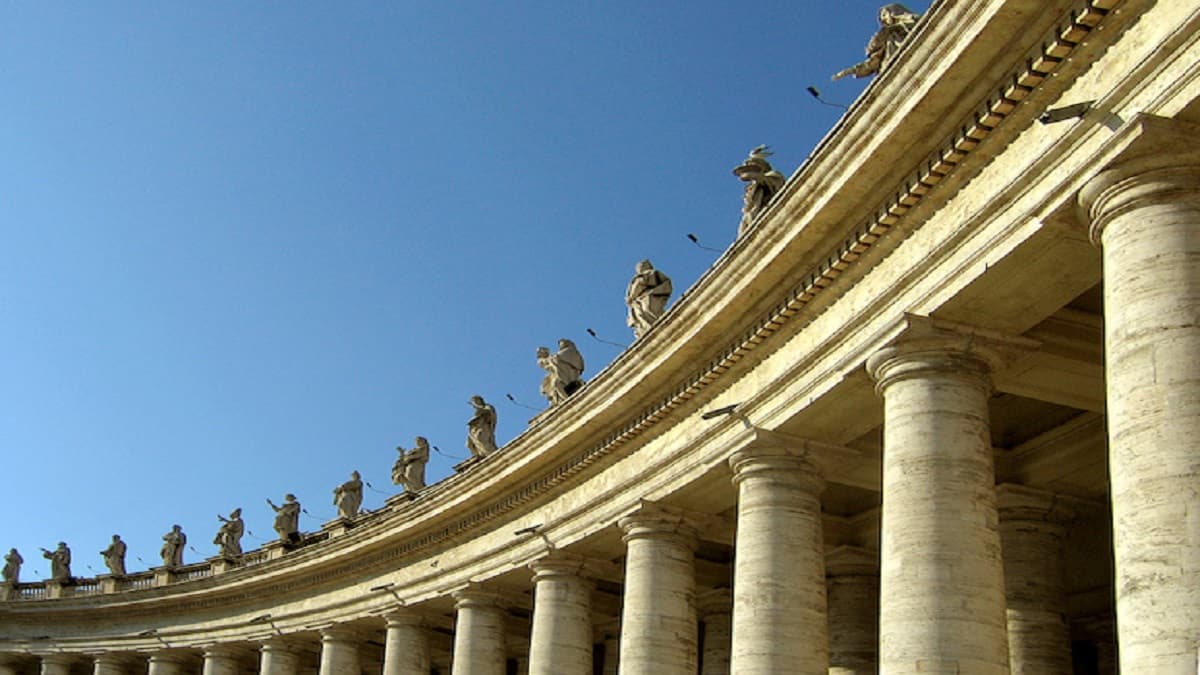The History of the Colonnades of St. Peter’s Square
The façade of Saint Peter’s was completed in 1614, and it was deemed necessary to rework the space in front of it in order to exalt the jewel of a basilica that had cost a century of hard work. The only fixed point was the obelisk that Fontana had erected years before.
In 1655, Fabio Chigi became Pope, taking the name of Alexander VII. Art collector and dabbler in architecture, on the very day of his election, he immediately sent for Gian Lorenzo Bernini to discuss projects for the Square. In 12 years, the pope commissioned the colonnade of San Pietro, the bronze throne of Saint Peter, and the Scala Regia in the Vatican; he reworked the squares of both the Pantheon and Minerva, in which the famous elephant obelisk was erected, and restored the Pyramid of Caius Cestius.
Bernini and Alexander VII celebrated the Catholic Church: the colonnade would never have existed without the exuberant baroque aesthetic, designed to convey devotion and emotional involvement to those who contemplate it.
The two men were contemporaries; they were both esteemed, and they worked together on the project of creating a portico, the elegant structure typical of the Greco-Roman cities that protected from the weather. It is this tribute to classic architecture that makes the colonnade the most sober example of the Roman Baroque creations.
It was a titanic undertaking. It took eleven years to build (1656-1667) using 44,000 cubic meters of travertine stone and hundreds of workers. The stone was transported from Tivoli (30 km from Rome) by land or towed along the banks of the River Tiber by horses and buffaloes.
The square is oval, closed by two semi-circular colonnaded porticoes that represent the Church’s embrace to the faithful but also to the "heretics, reconciling them with the Church; and to the infidels, enlightening them about the true faith." (Bernini). The widest point of the diameter measures 240 meters; the central obelisk and the two symmetrical fountains form the transversal axis.
The Doric colonnade has 284 16-meter-high columns, arranged in four rows to create 3 parallel lanes; the central lanes can be driven down with two pedestrian ones flanking them.
Optical illusions
The diameter of the columns gradually increases as it moves outward, correcting proportional distortion as it does so, and the façade is connected to the colonnade by two converging arms to make it appear closer.
Between the obelisk and the fountains, there are two stone disks on the floor with the words "centro del colonnato"—"centre" "of the colonnade.". These are the two focal points of the ellipse, or ‘foci’, and those who stand upon them can see the four rows of columns line up perfectly, making them seem like just one column.
The Statues
The colonnade is crowned with the Chigi coats of arms and 140 statues of saints that are 3.10 meters high—sculpted by Bernini's pupils—to exalt the many souls of Catholicism. They include St. Paul and the first martyr Stephen, the fathers of monasticism St. Benedict and St. Anthony the Great, the reformers of the medieval church St. Francis of Assisi and St. Dominic, and the "modern" St. Ignatius of Loyola and St. Philip Neri. There are also popes, martyrs who died during the Roman Empire, and 38 women.
Curiosity
The colonnade marks the border between Italy and the Vatican; a strip of travertine on the ground joins the two ends of the colonnade.
Together with the professional workers, there were also penitent volunteers who offered their labor for expiation of their sins.
A few meters from one of the two centers of the colonnade, a particular stone can be found in the "sampietrini" paving. This represents the Rose of the Winds, with the southwest wind the "libeccio.". In the middle of the red cobblestones that surround it there is one with a stylized heart in relief (almost certainly a decorative ivy leaf from the Roman age) that according to legend is the heart of Nero, the ferocious persecutor of the Christians who had put Saint Peter to death in that exact place, mysteriously re-emerged from the past, like a malign presence over which the Church has triumphed.

Vox City, The Vox Group's Dedicated Business-To-Consumer Arm For The Past Five Years, Is Staffed By Veteran Travel Industry Experts With A Combined 21 Years Of Expertise In The Tourism Industry. Let's Explore The Beauty Of Travel In Your Own Way At Your Own Pace.
Vox City International 63 Holly Walk | CV32 4JG Leamington Spa
2025 Vox City, All rights reserved.





